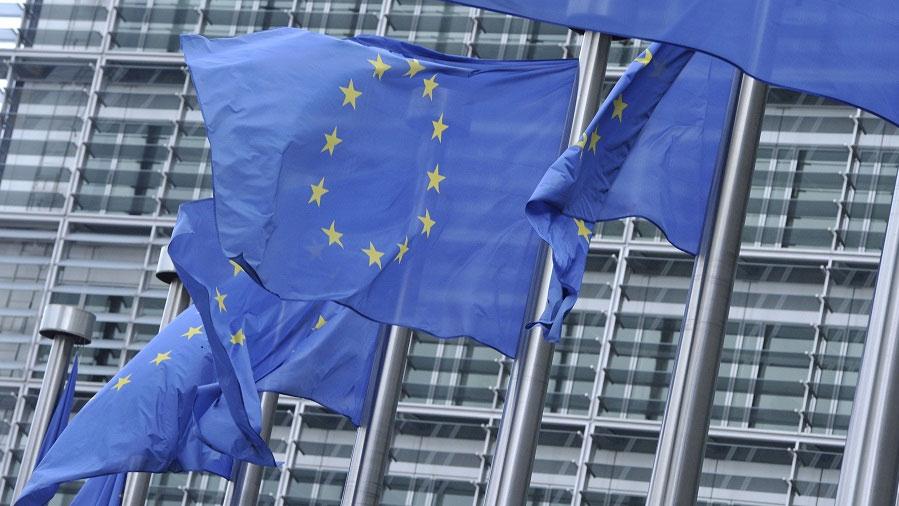
The European Union flags in front of EU headquarters in Brussels, Belgium. [Photo/Xinhua]
By Angel Talavera
The outlook for next year looks pretty grim. We see the eurozone's GDP contracting 0.1 percent in 2023, which is slightly below consensus.
However, a successful fall in demand for energy — aided by seasonally warm weather — and gas storage levels at near 100 percent capacity diminishes the risk of hard energy rationing during this winter.
By mid-year, the situation should improve as falling inflation allows for gains in real incomes and a recovery in the industrial sector. But with almost no Russian pipeline gas flowing into Europe next year, the continent will need to replace all the lost energy supplies.
So the 2023 macro story will largely be dictated by energy. An improved outlook for nuclear and hydroelectric output combined with a permanent degree of energy savings and fuel substitution away from gas means Europe could switch away from Russian gas without suffering a deep economic crisis.
We expect inflation to be lower in 2023, although the extended period of high prices this year poses a greater risk of higher inflation.
And with the near total end of Russian gas imports, Europe's efforts at replenishing inventories could push gas prices up in 2023.
The picture for core inflation looks less benign than for the headline figure, and we expect it to be high again in 2023, averaging 3.7 percent. A strong disinflationary trend coming from goods and a much stickier dynamic in service prices will shape the behavior of core inflation.
Non-energy goods inflation is high now, because of a shift in demand, persistent supply issues and pass-through of energy costs.
But the decline in global commodity prices, easing supply chain tensions, and high levels of the inventories-to-orders ratio suggest a turnaround is imminent.
With services representing two-thirds of the core, and over 40 percent of the total inflation, that's where the real battleground for inflation will be in 2023.
In most countries, real wages are seeing the greatest losses in years, and disposable income and consumer spending are still below pre-pandemic levels. Although stronger wage growth in 2023 will mean an improved background for households, real wage growth will remain close to zero.
With a global recession now part of our baseline scenario for 2023, we expect external demand for eurozone goods to decline next year. Consumer spending will be largely responsible for the final performance of the economy. It too should follow a path similar to GDP — a contraction over the next two quarters and a progressive recovery afterwards. This recovery is contingent on two main factors: a gradual rise in real income growth and a limited deterioration in the labor market.
With falling demand and tightening financial conditions, private investment will also decline. However, we expect total investment to grow, partly driven by a strong rise in projects financed by the Next Generation EU program coming online next year.
Industrial output is expected to decline a cumulative 3 percent between Q4 2022 and Q1 2023, nearly tripling the expected fall in GDP.
Non-intensive energy sectors have been remarkably resilient so far, possibly due to import substitution of energy-intensive intermediates and aided by government support schemes. Although the near-term prospects look dire for the industrial sector, there are reasons to be less pessimistic once the winter recession has passed. Capital goods makers are sitting on a historically high pile of backlogs thanks to a surge in post-pandemic demand and global supply chain bottlenecks limiting output and deliveries. There are also signs that the bottlenecks are easing.
European governments have provided ample support against the energy crisis.
While we do not expect a return to the austerity years of the early 2010s, the recent experience of the United Kingdom shows that the margin for error that markets will allow around what they consider sustainable fiscal policy is small. This will be particularly relevant for highly indebted countries such as Italy or Spain.
We expect a gradual shift in policy discussions in 2023 from immediate support for the economy to designing fiscal policy that is deemed sustainable in the medium term, such as the design of the new EU fiscal rules.
We expect the European Central Bank to stop its hiking cycle in early 2023, after having raised rates twice more between now and then (50 basis points in December and 25bps in February). But there is a real risk that the central bank will extend the tightening cycle a bit longer if the monthly inflation data trends do not show a meaningful change.
After implementing the fastest monetary tightening cycle in the eurozone's history, we expect the ECB to remain on hold for the rest of 2023. If that happens, it will open the door for a rate cut by the end of 2023 or early 2024.
However, if the eurozone faces an energy crisis this winter, leading to much higher-than-expected energy prices forcing a strong fiscal response, rate cuts will most likely be out of the question.
The author is the head of European Economics at Oxford Economics.

 中文
中文



